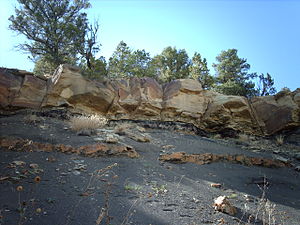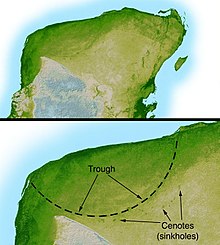From Wikipedia, the free encyclopedia
Contents
Possible causes
Alvarez impact hypothesis
Main article: Alvarez hypothesis

The K–Pg boundary exposure in Trinidad Lake State Park, in the Raton Basin of Colorado, USA, shows an abrupt change from dark to light colored rock.
The evidence for the Alvarez impact theory is supported by chondritic meteorites and asteroids which have an iridium concentration of ~455 parts per billion,[7] much higher than ~0.3 parts per billion typical of the Earth's crust.[5] Chromium isotopic anomalies found in Cretaceous–Paleogene boundary sediments are similar to those of an asteroid or a comet composed of carbonaceous chondrites. Shocked quartz granules and tektite glass spherules, indicative of an impact event, are also common in the K–Pg boundary, especially in deposits from around the Caribbean. All of these constituents are embedded in a layer of clay, which the Alvarez team interpreted as the debris spread all over the world by the impact.[5]
Using estimates of the total amount of iridium in the K–Pg layer, and assuming that the asteroid contained the normal percentage of iridium found in chondrites, the Alvarez team went on to calculate the size of the asteroid. The answer was about 10 km (6.2 mi) in diameter, about the size of Manhattan.[5] Such a large impact would have had approximately the energy of 100 trillion tons of TNT, or about 2 million times greater than the most powerful thermonuclear bomb ever tested.
One of the consequences of such an impact is a dust cloud which would block sunlight and inhibit photosynthesis for a few years. This would account for the extinction of plants and phytoplankton and of organisms dependent on them (including predatory animals as well as herbivores). However, small creatures whose food chains were based on detritus might have still had a reasonable chance of survival. It is estimated that sulfuric acid aerosols were injected into the stratosphere, leading to a 10–20% reduction in sunlight reaching the Earth's surface. It would have taken at least ten years for those aerosols to dissipate.[8][9]
Global firestorms may have resulted as incendiary fragments from the blast fell back to Earth. Analyses of fluid inclusions in ancient amber suggest that the oxygen content of the atmosphere was very high (30–35%) during the late Cretaceous. This high O
2 level would have supported intense combustion. The level of atmospheric O
2 plummeted in the early Paleogene Period. If widespread fires occurred, they would have increased the CO
2 content of the atmosphere and caused a temporary greenhouse effect once the dust cloud settled, and this would have exterminated the most vulnerable survivors of the "long winter".[8]
The impact may also have produced acid rain, depending on what type of rock the asteroid struck. However, recent research suggests this effect was relatively minor. Chemical buffers would have limited the changes, and the survival of animals vulnerable to acid rain effects (such as frogs) indicates that this was not a major contributor to extinction. Impact theories can only explain very rapid extinctions, since the dust clouds and possible sulphuric aerosols would wash out of the atmosphere in a fairly short time—possibly under ten years.[10]
Chicxulub Crater
Main article: Chicxulub Crater
When it was originally proposed, one issue with the "Alvarez hypothesis"
(as it came to be known) had been that no documented crater matched the
event. This was not a lethal blow to the theory; while the crater
resulting from the impact would have been larger than 250 km (160 mi) in
diameter, Earth's geological processes hide or destroy craters over
time.[11]Subsequent research, however, identified the Chicxulub Crater buried under Chicxulub on the coast of Yucatan, Mexico as the impact crater which matched the Alvarez hypothesis dating. Identified in 1990 based on the work of Glen Penfield done in 1978, this crater is oval, with an average diameter of about 180 km (110 mi), about the size calculated by the Alvarez team.[12]
K/T impact site on a contemporary world map (65 mya)[13]
4), which would have produced a vast SO
2 aerosol. This would have further reduced the sunlight reaching the Earth's surface and then precipitated as acid rain, killing vegetation, plankton and organisms which build shells from calcium carbonate (coccolithophorids and molluscs). The crater's shape suggests that the asteroid landed at an angle of 20° to 30° from horizontal and traveling north-west. This would have directed most of the blast and solid debris into the central part of what is now the United States. Most paleontologists now agree that an asteroid did hit the Earth at about the end of the Cretaceous leading to the extinction of non-avian dinosaurs.[14][15]
Gerta Keller, however, suggests that the Chicxulub impact occurred approximately 300,000 years before the K–Pg boundary.[11] This dating is based on evidence collected in Northeast Mexico, detailing multiple stratigraphic layers containing impact spherules, the earliest of which occurs approximately 10 m (33 ft) below the K–Pg boundary. This chronostratigraphic sequence of rock is thought to represent 300,000 years. This finding supports the theory that one or many impacts were contributory, but not causal, to the K–Pg boundary mass extinction.[11] However, many scientists reject Keller's analysis, some arguing that the 10-m (33-ft) layer on top of the impact spherules should be attributed to tsunami activity resulting from impact. Few researchers support Keller's dating of the impact crater.[14]
Deccan Traps
Main article: Deccan Traps
Before 2000, arguments that the Deccan Traps flood basalts
caused the extinction were usually linked to the view that the
extinction was gradual, as the flood basalt events were thought to have
started around 68 Ma and lasted for over 2 million years. However, there
is evidence that two-thirds of the Deccan Traps were created within 1
million years about 65.5 Ma, so these eruptions would have caused a
fairly rapid extinction, possibly a period of thousands of years, but
still a longer period than what would be expected from a single impact
event.[16][17]The Deccan Traps could have caused extinction through several mechanisms, including the release of dust and sulphuric aerosols into the air which might have blocked sunlight and thereby reduced photosynthesis in plants. In addition, Deccan Trap volcanism might have resulted in carbon dioxide emissions which would have increased the greenhouse effect when the dust and aerosols cleared from the atmosphere.[17]
In the years when the Deccan Traps theory was linked to a slower extinction, Luis Alvarez (who died in 1988) replied that paleontologists were being misled by sparse data. While his assertion was not initially well-received, later intensive field studies of fossil beds lent weight to his claim. Eventually, most paleontologists began to accept the idea that the mass extinctions at the end of the Cretaceous were largely or at least partly due to a massive Earth impact. However, even Walter Alvarez has acknowledged that there were other major changes on Earth even before the impact, such as a drop in sea level and massive volcanic eruptions that produced the Indian Deccan Traps, and these may have contributed to the extinctions.[18]
Multiple impact event
Several other craters also appear to have been formed about the time of the K–Pg boundary. This suggests the possibility of near simultaneous multiple impacts, perhaps from a fragmented asteroidal object, similar to the Shoemaker-Levy 9 cometary impact with Jupiter. Among these are the Boltysh crater, a 24-km (15-mi) diameter impact crater in Ukraine (65.17 ± 0.64 Ma); and the Silverpit crater, a 20-km (12-mi) diameter impact crater in the North Sea (60–65 Ma). Any other craters that might have formed in the Tethys Ocean would have been obscured by erosion and tectonic events such as the relentless northward drift of Africa and India.[19][20][21]A very large structure in the sea floor off the west coast of India has recently been interpreted as a crater by some researchers.[22] The potential Shiva crater, 450–600 km (280–370 mi) in diameter, would substantially exceed Chicxulub in size and has also been dated at about 66 mya, an age consistent with the K–Pg boundary. An impact at this site could have been the triggering event for the nearby Deccan Traps.[23] However, this feature has not yet been accepted by the geologic community as an impact crater and may just be a sinkhole depression caused by salt withdrawal.[21]
Maastrichtian marine regression
Clear evidence exists that sea levels fell in the final stage of the Cretaceous by more than at any other time in the Mesozoic era. In some Maastrichtian stage rock layers from various parts of the world, the later ones are terrestrial; earlier ones represent shorelines and the earliest represent seabeds. These layers do not show the tilting and distortion associated with mountain building; therefore, the likeliest explanation is a regression, that is, a buildout of sediment, but not necessarily a drop in sea level. No direct evidence exists for the cause of the regression, but the explanation which is currently accepted as the most likely is that the mid-ocean ridges became less active and therefore sank under their own weight as sediment from uplifted orogenic belts filled in structural basins.[24][25]A severe regression would have greatly reduced the continental shelf area, which is the most species-rich part of the sea, and therefore could have been enough to cause a marine mass extinction. However, research concludes that this change would have been insufficient to cause the observed level of ammonite extinction. The regression would also have caused climate changes, partly by disrupting winds and ocean currents and partly by reducing the Earth's albedo and therefore increasing global temperatures.[26]
Marine regression also resulted in the reduction in area of epeiric seas, such as the Western Interior Seaway of North America. The reduction of these seas greatly altered habitats, removing coastal plains that ten million years before had been host to diverse communities such as are found in rocks of the Dinosaur Park Formation. Another consequence was an expansion of freshwater environments, since continental runoff now had longer distances to travel before reaching oceans. While this change was favorable to freshwater vertebrates, those that prefer marine environments, such as sharks, suffered.[27]






No comments:
Post a Comment